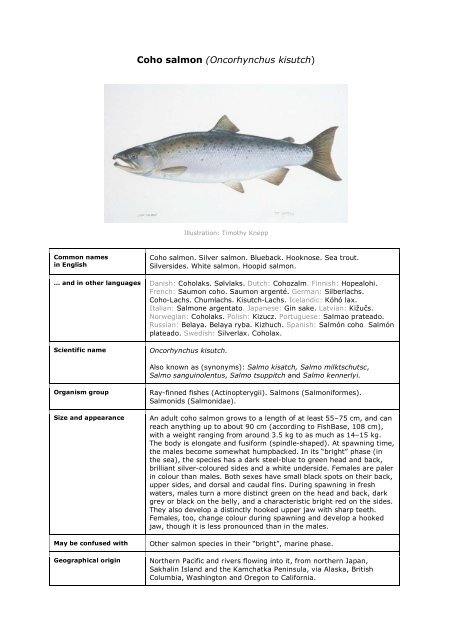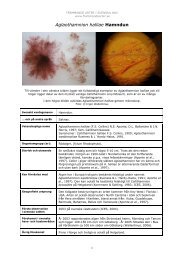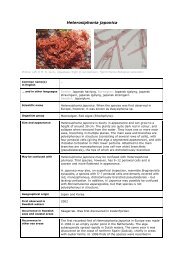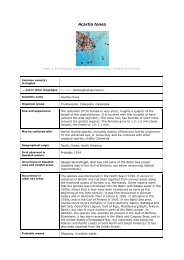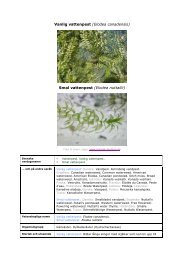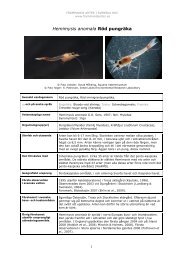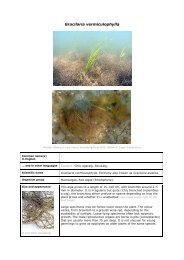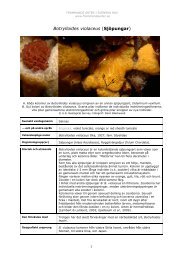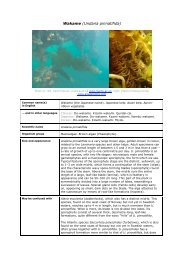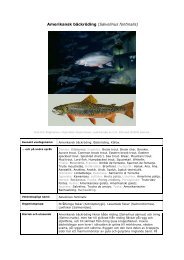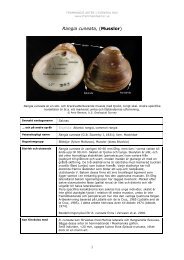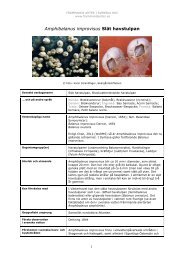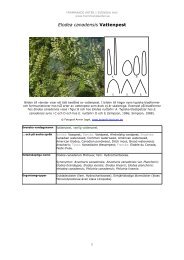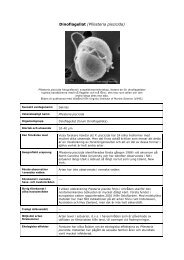ENG Onchorhynchus_kisutch
ENG Onchorhynchus_kisutch
ENG Onchorhynchus_kisutch
Create successful ePaper yourself
Turn your PDF publications into a flip-book with our unique Google optimized e-Paper software.
Common names<br />
in English<br />
Coho salmon (Oncorhynchus <strong>kisutch</strong>)<br />
Illustration: Timothy Knepp<br />
Coho salmon. Silver salmon. Blueback. Hooknose. Sea trout.<br />
Silversides. White salmon. Hoopid salmon.<br />
… and in other languages Danish: Coholaks. Sølvlaks. Dutch: Cohozalm. Finnish: Hopealohi.<br />
French: Saumon coho. Saumon argenté. German: Silberlachs.<br />
Coho-Lachs. Chumlachs. Kisutch-Lachs. Icelandic: Kóhó lax.<br />
Italian: Salmone argentato. Japanese: Gin sake. Latvian: Kižučs.<br />
Norwegian: Coholaks. Polish: Kizucz. Portuguese: Salmao prateado.<br />
Russian: Belaya. Belaya ryba. Kizhuch. Spanish: Salmón coho. Salmón<br />
plateado. Swedish: Silverlax. Coholax.<br />
Scientific name Oncorhynchus <strong>kisutch</strong>.<br />
Also known as (synonyms): Salmo kisatch, Salmo milktschutsc,<br />
Salmo sanguinolentus, Salmo tsuppitch and Salmo kennerlyi.<br />
Organism group Ray-finned fishes (Actinopterygii). Salmons (Salmoniformes).<br />
Salmonids (Salmonidae).<br />
Size and appearance An adult coho salmon grows to a length of at least 55–75 cm, and can<br />
reach anything up to about 90 cm (according to FishBase, 108 cm),<br />
with a weight ranging from around 3.5 kg to as much as 14–15 kg.<br />
The body is elongate and fusiform (spindle-shaped). At spawning time,<br />
the males become somewhat humpbacked. In its “bright” phase (in<br />
the sea), the species has a dark steel-blue to green head and back,<br />
brilliant silver-coloured sides and a white underside. Females are paler<br />
in colour than males. Both sexes have small black spots on their back,<br />
upper sides, and dorsal and caudal fins. During spawning in fresh<br />
waters, males turn a more distinct green on the head and back, dark<br />
grey or black on the belly, and a characteristic bright red on the sides.<br />
They also develop a distinctly hooked upper jaw with sharp teeth.<br />
Females, too, change colour during spawning and develop a hooked<br />
jaw, though it is less pronounced than in the males.<br />
May be confused with Other salmon species in their “bright”, marine phase.<br />
Geographical origin Northern Pacific and rivers flowing into it, from northern Japan,<br />
Sakhalin Island and the Kamchatka Peninsula, via Alaska, British<br />
Columbia, Washington and Oregon to California.
First observed in<br />
Swedish waters<br />
Occurrence in Swedish<br />
seas and coastal areas<br />
Occurrence in<br />
other sea areas<br />
Probable means<br />
of introduction<br />
Habitat(s) in which<br />
species occurs<br />
In 1984, off southern Gotland.<br />
The only record of the species is from 1984, when a coho salmon was<br />
caught in salmon nets off southern Gotland – possibly a stray from<br />
stocking carried out in the then Soviet Union. (The species may not be<br />
released into Swedish waters without a special permit.)<br />
The species came to Europe in the 1970s, when it was deliberately<br />
introduced into France. It found its way into the wild in 1974, when<br />
50,000 yearlings escaped from a fish farm into the river Varenne in<br />
Normandy. Between 1975 and 1979 similar incidents occurred in other<br />
parts of France. Adult fish were caught between 1975 and 1977 in<br />
various rivers of northern France and in the English Channel. Finds of<br />
coho salmon have also been reported from Belgium and the<br />
Netherlands.<br />
In addition, the species has been introduced to the Great Lakes of the<br />
United States and Canada, and to Argentina and Chile. According to<br />
FishBase, coho salmon also occurs as an introduced species in the<br />
Mediterranean (Israel, Cyprus, Greece and Italy).<br />
There are reports of the species being stocked in the eastern Baltic in<br />
the 1970s. It was observed in German waters in 1974 and in Latvian<br />
waters in 1980. Finds have also been reported from Estonia.<br />
Aquaculture and recreational fisheries (stocking).<br />
Like other salmon species, coho salmon are anadromous, i.e. they live<br />
in the sea but, after 1–2 years there, migrate into rivers (fresh waters)<br />
in the autumn and winter to spawn. At that point, the fish are<br />
generally 3–5 years old. Juveniles usually develop for a year or more<br />
in rivers before descending to the sea. In the sea, coho salmon can be<br />
found at various depths, from near the surface down to about 250 m.<br />
This is a coldwater species, doing best at water temperatures of<br />
around 12–14°C, which is close to its optimum temperature for<br />
growth. When young fish were exposed to temperatures above 25°C<br />
they died.<br />
In a freshwater environment, young coho salmon feed mainly on<br />
insects, while in inshore waters their diet consists of small fish, such as<br />
herring (Clupea harengus), and crustaceans. In the open sea, adults<br />
live on larger fish. When they ascend rivers to spawn, coho salmon<br />
stop feeding, and after spawning the parents die.<br />
Some populations of coho salmon in British Columbia spend their<br />
entire lives in fresh waters.<br />
Ecological effects Non-native salmonids may compete with other species for food and<br />
space, and bring with them parasites and diseases that could affect<br />
native species. Discussion about the impacts of such introductions,<br />
however, has mostly focused on the risk of genetic effects as a threat<br />
to indigenous salmonid species. Stocking of salmonids is practised on a<br />
large scale and, what is more, hatchery-reared fish quite often escape<br />
into the wild.<br />
In this context, “genetic effects” means changes in the genetic makeup<br />
of native species that can result from the incorporation of genes<br />
from the new organisms. The risks associated with introducing nonnative<br />
populations or genes into the natural environment come under<br />
three main headings: extinction, hybridization, and loss of genetic
variation.<br />
When closely related species or distinct populations of a single species<br />
interbreed, hybridization can result. This can happen if individuals of a<br />
non-native species mate with individuals of a native one. The offspring<br />
exhibit characteristics differing, to a greater or lesser degree, from<br />
those of the native parent. In the long term, this may result in wild<br />
populations of a species losing some of their ability to adapt to their<br />
environment. Stocked fish, for example, are less well adapted to their<br />
new environment than the wild fish with which they mix.<br />
At worst, the introduction and spread of non-native populations or<br />
genes may drive native species to extinction. This may happen either<br />
because the native species is outcompeted and displaced, or because<br />
of genetic changes in the offspring (hybrid) of the alien and native<br />
species which mean that the offspring is unable to survive. If the<br />
hybrid is fertile, however, the next step may be an exchange of genes<br />
with the parent population. Non-native genetic material will then be<br />
incorporated into the native species, and in the long run the effect of<br />
this could be to eliminate local variants.<br />
Non-indigenous salmonid species that are stocked in Swedish waters,<br />
then, may form hybrids with native species. Often these hybrids are<br />
fertile, which means that they are able to reproduce in the wild. This is<br />
true, for example, of “sparctic char” (also known as “sparctic trout” or<br />
“spar”, a cross between brook trout Salvelinus fontinalis and Arctic<br />
char S. alpinus), “larctic char” (lake trout Salvelinus namaycush and<br />
Arctic char), and “splake” (male brook trout and female lake trout).<br />
Mixing of non-native species or genetic variants with local populations<br />
may have implications for Sweden’s populations of Arctic char, Atlantic<br />
salmon (Salmo salar) and brown trout (Salmo trutta). Over time,<br />
native salmonid stocks have adapted to conditions in their particular<br />
lakes and rivers, gradually becoming genetically distinct from every<br />
other stock of the same species. The loss of such local adaptations<br />
may leave a population less well equipped to survive.<br />
Stocking of hatchery-reared fish can also lead to inbreeding<br />
depresssion. This occurs when closely related individuals mate with<br />
one another, and may result in offspring that are unviable or have<br />
difficulty surviving.<br />
FIND OUT MORE<br />
• North European and Baltic Network on Invasive Alien Species: Oncorhynchus <strong>kisutch</strong><br />
http://www.nobanis.org/speciesInfo.asp?taxaID=1623<br />
• Baltic Sea Alien Species Database: Oncorhynchus <strong>kisutch</strong><br />
http://www.ku.lt/nemo/directory_details.php?sp_name=Oncorhynchus+<strong>kisutch</strong><br />
• FishBase: Oncorhynchus <strong>kisutch</strong><br />
http://www.fishbase.org/summary/SpeciesSummary.php?id=245&lang=English<br />
• FAO: Fisheries Global Information System (FIGIS): Oncorhynchus <strong>kisutch</strong><br />
http://www.fao.org/figis/servlet/species?fid=2118<br />
• European Nature Information System Database (EUNIS): Oncorhynchus <strong>kisutch</strong><br />
http://eunis.eea.europa.eu/species-factsheet.jsp?idSpecies=9980&idSpeciesLink=9980<br />
http://www.ittiofauna.org/webmuseum/pesciossei/salmoniformes/salmonidae/salmonidae.htm<br />
• Alaska Department of Fish & Game: Coho salmon<br />
http://www.adfg.state.ak.us/pubs/notebook/fish/coho.php<br />
• Environment Canada: Do you know Coho salmon?<br />
http://www.pac.dfo-mpo.gc.ca/species/salmon/salmon_facts/coho_e.htm<br />
• University of Toronto: Coho salmon<br />
http://www.zoo.utoronto.ca/manuesteve/UTCoho.html
• University of British Colombia: Coho salmon<br />
http://www.zoology.ubc.ca/~keeley/coho.htm<br />
• Canadian Sportsfishing: Coho salmon<br />
http://www.canadian-sportfishing.com/Tips&Techniques/Species_Info/Default1.asp?Species_Name=COHO SALMON<br />
• Ontario Federation of Anglers and Hunters: Ontario's fish: Coho salmon<br />
http://www.ofah.org/fishing/description.cfm?Species=Cold_Water&FishID=21<br />
• Washington Department of Fish and Wildlife: Salmon factsUS Geological Survey:<br />
Nonindigenous Aquatic Species: Oncorhynchus <strong>kisutch</strong><br />
http://nas.er.usgs.gov/queries/FactSheet.asp?speciesID=908<br />
• NOAA: Coho salmon<br />
http://www.glerl.noaa.gov/pubs/photogallery/Fish/pages/1071.html<br />
• Mt. Baker-Snoqualmie National Forest Pacific Northwest Fisheries Program: Coho<br />
http://www.fs.fed.us/r6/fishing/forests/fishresources/mtbsno_salmon.html#coho<br />
• National Wildlife Foundation: Coho salmon<br />
http://www.enature.com/fieldguides/detail.asp?shapeID=994&curGroupID=3&lgfromWhere=&curPageNum=8<br />
• Wisconsin Sea Grant: Coho salmon<br />
http://www.seagrant.wisc.edu/greatlakesfish/cohosalmon.html<br />
• Trout Unlimited: Coho salmon<br />
http://www.tucalifornia.org/coho.htm<br />
• NatureServe Explorer: Oncorhynchus <strong>kisutch</strong><br />
http://www.natureserve.org/explorer/servlet/NatureServe?searchName=Oncorhynchus <strong>kisutch</strong><br />
• Trouts and Seasons of The Mountain Village: Oncorhynchus <strong>kisutch</strong><br />
http://www.amago.jp.lv/trout/trout42.html<br />
IMAGES CREDIT<br />
Illustration: Timothy Knepp. Published by U. S. Fish & Wildlife Services, Digital Library System<br />
http://images.fws.gov/<br />
• This factsheet on Oncorhynchus <strong>kisutch</strong> was created on 30 November 2006<br />
• First update: 15 January 2007<br />
• Translated by Martin Naylor on 22 January 2007


